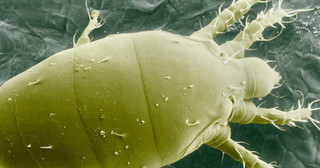How Do You Know if You Have Broad Mites?
Identifying broad mites can be very difficult, as these microscopic species in the arachnid family aren’t usually detected until crop damage appears.
The first indications of broad mite damage usually occur on young leaves near the petiole. Deformed growth or dark brown spots or streaks on the leaf can be symptoms of broad mite infestation. Still, only an evaluation of the leaf with 20-40x or higher magnification will positively identify broad mite as the culprit.
What Plants Do Broad Mites Like?
The broad mite (Polyphagotarsonemus latus) is found in a wide range of host plants: cannabis, peppers, cucumber, aubergine, and many ornamental crops.
What Do Broad Mites Look Like?
Broad mites resemble most other mite species in shape but are much smaller than spider mite or predatory mite species. They are usually opaque or cream-colored and occur on the underside of leaves.
Male broad mites are smaller than females and have long legs. They are the same color as the females, with the latter having a white stripe down their back.
What Does Broad Mite Damage Look Like?
Damage caused by broad mites can look similar to that caused by viruses and could be mistaken with disease or with pesticide spray injury. It is commonly misdiagnosed in outdoor ornamental crops as growth regulator over application or damage from non-target herbicide drift. They usually prefer developing plant tissue like young leaves and flower buds. The lower leaves tend to remain unaffected while the younger receive severe damage.
Moderate infestations cause brown or bronze collapsed spots and stripes forming a fine network on the leaves. With developed hot spots, green tissue is not visible anymore. Usually, leaf veins are untouched, contrasting against the bronzed color. Harmed tissue and misshapen growth also happens on fruit, as broad mites sucking pierce and kill cells. Flowers are often discolored and deformed.
Relatively low populations can cause extensive damage.
How Do Broad Mites Spread?
Like most pests, broad mites spread by mechanical means within a crop: on tools, clothing, or plant material, they can survive in a facility that regularly cycles new plants without properly sterilizing between crops.
Broad mites can also attach themselves to other pests' legs, like whiteflies and aphids, for larger distances dispersal.
How to Prevent Broad Mites
A recommended method to prevent broad mites is to introduce its natural predators, Amblyseius californicus and Amblyseius swirskii, in advance. With a sachet introduction, they will emerge for 3-5 weeks and establish on the plant before the pest appears; the earlier predatory mites are present in the crop, the better.
As both the activity of broad mites and their reproduction rate depends on your plant's environment, always consider the ambient temperature and relative humidity to prevent them. In addition, scout regularly to be able to detect the pest presence on time to act.
Contact us for more information about release dosages.
How to Control Broad Mites?
The predatory mites Neoseiulus cucumeris and Amblyseius swirskii prey on tarsonemids and effectively control broad mites. Amblyseius californicus can also control this mite when introduced early in the growing cycle.
Also, removing affected plants or plant parts and lowering the relative humidity can contribute to the control of broad mites.
Always consider the method of choice, and its results will largely depend on the variables that are unique to your crop. If you'd like further assistance implementing an IPM program, don't hesitate to contact our customer service team.
What Kills Broad Mites in Cannabis?
Broad mite infestations can be treated in several ways:
First, you have to dispose of the part plants or plants with infected tissue to stop the spreading.
The use of insecticidal soaps and neem oil can be used when controlling this pest but is not recommended as it can come out too harsh and affect the taste and smell of your buds. Heat treatment, dunking plants in hot water, and overheating the grow space, are other methods that could harm your plants and aren’t recommended.
Biological control of broad mites using predatory mites as preventive and curative measures can help you solve the situation and avoid using pesticides and harsh chemicals in your cultivation. Broad mites natural enemies such as predatory mites A. californicus and A. swirskii actively search their prey and keep the pest under control.



